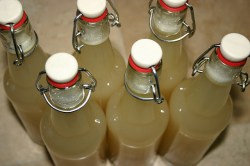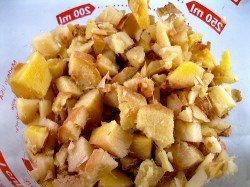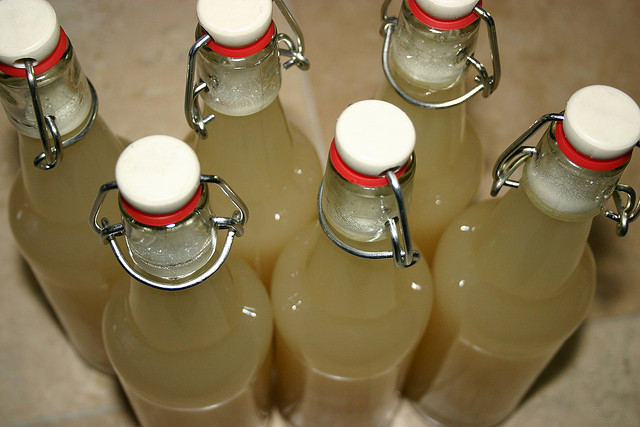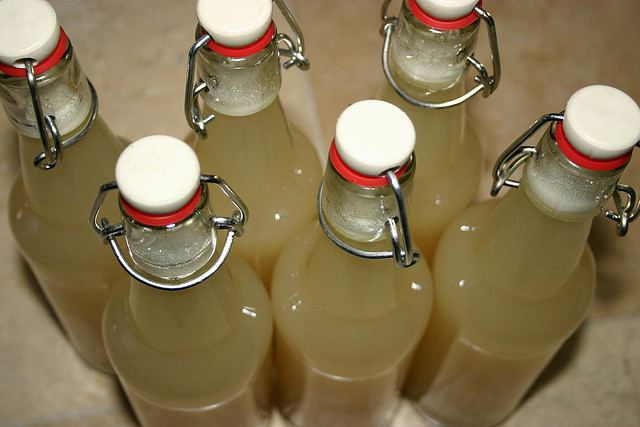
Photo by Reese Lloyd.
The following recipe is from the book The Art of Fermentation: An In-Depth Exploration of Essential Concepts and Processes from Around the World. Read more from the author, Sandor Katz, here.
Ginger beer is a classic flavor of homemade soda. It can be made lightly gingered, like most commercial ginger ale, or as spicy as you can take it, using lots of ginger. A ginger bug is a simple ginger beer starter (it can also be used as a starter for other beverages) made from ginger, sugar, and water. Ginger beer can also be made with many different types of starters.
Ginger beer and ginger bug recipe
 1. A ginger bug could not be easier to start: Grate a bit of ginger (with skin) into a small jar, add some water and sugar, and stir.
1. A ginger bug could not be easier to start: Grate a bit of ginger (with skin) into a small jar, add some water and sugar, and stir.
2. Stir frequently, and add a little more grated ginger and sugar each day for a few days, until the mixture is vigorously bubbly. Gingerroots are rich in yeasts and lactic acid bacteria, so ginger bugs usually get bubbly quickly. However, many people have reported that their ginger bugs never get bubbly. My theory is that most of the ginger imported into the United States has undergone irradiation, thus destroying its bacteria and yeast. Foods marketed as organic cannot be irradiated (according to the U.S. Department of Agriculture’s organic standards), so for best results make ginger bug with organic ginger, or ginger from a known, non-irradiated source.
3. Once your bug is vigorously bubbly (or you have one of the other starters), prepare a ginger decoction that will become your ginger beer. I like to make a concentrated decoction that cools to body temperature as it is later diluted with cold water. To make such a concentrate, fill a cooking pot with water measuring about half the volume of ginger beer you wish to make. Add finely sliced or grated ginger, using two to six inches of gingerroot (or more) for each gallon of ginger beer you are making (though only half this volume is in the pot).
4. Bring to a boil, then gently simmer the ginger, covered, for about 15 minutes. If in doubt about how much ginger to add, experiment. Start with a smaller amount, taste after boiling (and diluting), and if a stronger flavor is desired, add more and boil another 15 minutes.
5. After boiling the ginger, strain the liquid into an open fermentation vessel (crock, wide-mouth jar, or bucket), discarding the spent ginger pieces (or leave the ginger in and strain later). Add sugar. I usually use two cups of sugar per gallon (of target volume, still requiring more water), but you might like it a little sweeter than I do.
6. Once sugar is dissolved in hot ginger water, add additional water to reach the target volume. This will cool your sweet ginger decoction. If it feels hot to the touch, leave it a few hours to cool before adding ginger bug or other starter. If it feels no warmer than body temperature, go ahead and add ginger bug or other starter. Add a little lemon juice too, if you like.
7. Stir well. Cover with a cloth to protect from flies and leave to ferment in the open vessel, stirring periodically, until the ginger beer is visibly bubbly, anywhere from a few hours to a few days depending upon temperature and the potency of the starter.
8. Once your ginger beer is bubbly, you can bottle it. If you wish to minimize alcohol content, bottle it quickly, and give it a short time to ferment in the bottle. If you prefer a more alcoholic brew, leave it to ferment for several days before bottling. Observe daily and bottle after bubbling has peaked and begun to slow down. Either way, in bottling, always be aware of the possible dangers of overcarbonation. Leave bottles to ferment at ambient temperatures until they become carbonated. Gauge carbonation with a plastic soda bottle. When it resists squeezing between your fingers and no longer yields easily, it is carbonated. Refrigerate bottles to cool and prevent further carbonation. Ginger beer will continue to slowly ferment (and pressurize) in the refrigerator, so enjoy it within a few weeks.
I’ve also made starters from other similar rhizomes, specifically turmeric and galangal, with wonderful results. I made raw soft drinks with each of them by placing grated roots into a bottle with light sugar water, and leaving to ferment about a week. Sparkly and delicious!



